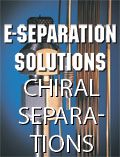Chiral Separations
Chiral has long been one of the most important techniques in separation science. Joining us for this discussion are Martin Vollmer of Agilent Technologies and Elena Eksteen of Chiral Technologies.

Chiral has long been one of the most important separation techniques in the field of separation science. Used in a variety of application areas, Chiral separations continue to grow in popularity and utility.
Joining us for this discussion are Martin Vollmer of Agilent Technologies and Elena Eksteen of Chiral Technologies, Inc.
What’s new in the chiral separations industry?
Eksteen: The advent of a new generation of immobilized chiral stationary phases (CSP) led to the development of very successful separation methods for chiral molecules of low solubility, which was not feasible previously. The availability of columns packed with the most popular immobilized CSPs in 3-μm particles now allows researchers to conduct high-throughput screening with a high success hit rate, thus maximizing the number of analysis per day while reducing cost per sample.
Which applications benefit the most from the advantages of chiral separations?
Vollmer:The determination of enantiomeric excess was previously very difficult with SFC especially if one enantiomer occurred at low levels in the analyte mixture.
Eksteen:Providing enantiomers of chiral molecules for toxicology studies and clinical trials remains the major application of chiral stationary phases, since enantiomers with undesirable characteristics can be rapidly eliminated. In addition, protein-binding studies undertaken during the drug discovery process can now be successfully and routinely carried out employing protein-based columns.
Considering the state of the economy and last year’s acetonitrile shortage, what trends do you expect to see in 2010 for chiral separations?
Vollmer:The market for SFC will increase significantly since, with SFC, usually no acetonitrile is needed and only small amounts of alcoholic modifiers are usually added. This does not only reduce costs, but it also reduces waste and costly disposal of organic solvent. Therefore SFC is really a green technology.
Eksteen:There were a number of major acquisitions and mergers in the pharmaceutical industry last year. The industry consolidation will continue in 2010. Cost-cutting measures taken by pharmaceutical companies are resulting in outsourcing of R&D and process development. We expect to see more opportunities for custom separation services in 2010.
What are some of the challenges facing chiral separations research and development and how can they be overcome in the future?
Vollmer:SFC has not had the best reputation in the past since it suffered from robustness and it was extremely difficult to achieve high sensitivity and reproducibility. As it is now becoming as sensitive and robust as HPLC, more chemists will consider to switch. It also requires much less knowledge than before, even the same instrument and software that has been used for HPLC in the past can be used in SFC. Chiral separations with SFC are also significantly faster than with standard HPLC due to the low solvent viscosity and superior diffusion characteristics.
Eksteen:With the market for biological drugs growing rapidly, it appears that the role of R&D in the area of traditional small molecules as drug targets is diminishing. However, new applications for small chiral molecules can be identified. Therapeutic antibodies have changed the cancer treatment landscape over the past decade. Use of conjugated antibodies for cancer treatment is a growing area in protein therapeutics and is being explored by pharmaceutical companies. Conjugated antibodies contain cancer-killing agents that are typically small molecules. Market growth for the conjugated antibodies will provide new opportunities for enantioselective separations of small molecules. The area of proteomics, as well as the elucidation of the absolute configuration of enantiomers, will also bring new applications for the chiral separations industry.
What is one change/improvement you hope to see in the chiral separations industry over the next few years?
Vollmer: More people that do currently normal phase and reversed-phase separation of chiral compounds should adopt SFC technology, to cut down their solvent costs and to minimize their waste production. I would also like to see further improvements especially in preparative SFC, method development capabilities, and stationary phase development such that SFC really becomes the mainstream separation and purification technology for chiral compound separation.
Eksteen:The ongoing cooperation between academia and pharmaceutical companies is a growing trend in drug discovery research. My company is on the forefront of this endeavor, assisting academia in establishing effective infrastructures for analysis of chiral molecules.
If you are interested in participating in any upcoming Technology Forums please contact Associate Editor Meg Evans for more information. Next month’s forums will focus on the Sample Prep SFC and Food Analysis/Quality markets.
Regulatory Deadlines and Supply Chain Challenges Take Center Stage in Nitrosamine Discussion
April 10th 2025During an LCGC International peer exchange, Aloka Srinivasan, Mayank Bhanti, and Amber Burch discussed the regulatory deadlines and supply chain challenges that come with nitrosamine analysis.









